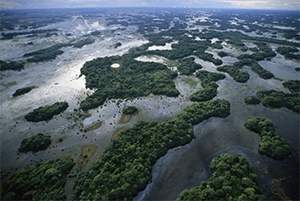Research project
Metagenomics for community ecology; a next generation of eDNA monitoring tool for biomass studies in freshwater environments
How can we quantify the density of species within a community through environmental DNA concentrations?
- Duration
- 2015 - 2019
- Contact
- Krijn Trimbos
- Partners
Partners
- We are closely working together with the researchers involved in the Project Waterscan at Naturalis.
- B. (Berry) van der Hoorn, MSc., Naturalis
- Leiden Institute of Advanced Computer Science
- Centre for Geogenetics
- Lisette Waits, University of Idaho
- We are closely working together with the researchers involved in the Project Waterscan at Naturalis.

In a time of severe global biodiversity decline, ecological studies are ever more important for understanding this decline. Subsequently, science based and effective management of biodiversity can be achieved with such knowledge. To understand the decline of species the natural and unnatural changes of the communities in which these species live must be understood. Unfortunately, large scale, but detailed datasets, based on morphology, of community composition in the field are rare. The recent possibility to assess environmental DNA (eDNA), i.e., fragments of DNA present in air, water and soil, through next generation sequencing techniques, promises the ability to determine the different species within a community through the assessment of DNA. However, up until now, it is still unclear how exactly biotic (species, life stage) and abiotic factors (pH and temperature) biomass or species related factors, like DNA excretion rates and life cycle stage, influence eDNA concentration and persistence. Without a detailed understanding of the relationship between species density and relative eDNA concentration, eDNA assessment cannot be used to address biodiversity studies. This study will investigate and model the relationship between biomass and eDNA concentration, so that ultimately eDNA can be used as an effective community monitoring tool for biodiversity studies.
This research will be primarily lab oriented. Calibration studies will be conducted in controlled setups. Different species will be added to micro and mesocosms, while parameters such as pH, temperature, interaction possibilities between species and life stage will be varied to see its effects on eDNA concentrations in these otherwise controlled settings. The relationship between biomass and eDNA concentration will be monitored and modeled. This will enable us to predict biomass (=density) of different species on the basis of eDNA concentrations.
The CML is perfectly equipped to handle these kind of studies. The department of Conservation Biology at CML (CML-CB) has a long tradition in studying aquatic and terrestrial community responses to anthropogenic changes. Moreover, we have strong expertise in linking environmental and conservation questions to genetic tools. Research has been done on the population dynamics and phylogeographical relationships of (gene flow, genetic differentiation, relatedness) species as well as on the genetic structure of species on the basis of mitochondrial, nuclear DNA and ancient DNA. Also meta-genomic approaches have been employed, e.g. to determine soil microbial structure under the influence of global warming.
